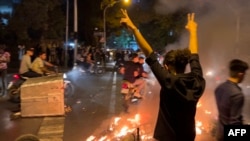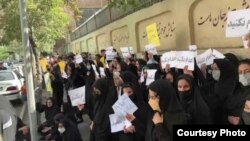
NOTE TO READERS: This week's newsletter is being published one day earlier to report on the strong reaction across Iran to the death of Mahsa Amini.
Welcome back to The Farda Briefing, an RFE/RL newsletter that tracks the key issues in Iran and explains why they matter.
I'm RFE/RL correspondent Golnaz Esfandiari. Here's what I’ve been following during the past week and what I’m watching for in the days ahead.
The Big Issue
The death of a young woman following her arrest by Tehran’s morality police has led to widespread outrage among Iranians while sparking several days of protests.
Mahsa Amini, 22, was detained in Tehran on September 13 while visiting the capital with her family. She died three days later in a hospital after slipping into a coma while in the custody of the police, who have maintained that she suffered a heart attack while denying claims by activists that she may have been beaten while taken to the police station to be “educated.”
Her family has said that Amini didn’t have any previous health problems. Her father, Amjad Amini, told an Iranian news website that witnesses saw her being shoved into a police car.
The government has ordered an investigation amid fury on social media, as well as several days of angry protests in her hometown of Saghez and a dozen other cities in Iran’s Kurdistan as well as in Tehran and Rasht, according to amateur videos posted online. Protests also took place in several universities in the Iranian capital, Isfahan, and Tabriz.
Why It Matters: Amini’s death comes amid a tightening of Iran’s hijab crackdown and increased pressure on women who flout the rules. Regardless of whether Amini was beaten up or not, her tragic death has highlighted several decades of state harassment of women who don’t fully respect the hijab restrictions.
Many Iranians have in the past days called for abolishing the morality police and an end to the hijab rule that became compulsory in 1981, two years after the Islamic Revolution. In recent days, women protesting Amini’s death have removed their head scarves in public and waved them defiantly, while some have set fire to them to show their anger and their opposition to the forced hijab.
“Justice, freedom, and optional hijab,” as well as, "Death to the dictator" were some of the chants of protesters in the Iranian capital, where an iconic photo also shows a young woman burning her hijab and showing the victory sign while standing on top of a car.
What’s Next: The establishment has used force and Internet disruption in an attempt to end the protests over Amini’s death, which led to calls for an end to the Islamic republic. The state repression will only lead to increased antiestablishment sentiment, as well as growing public opposition against the morality police and the hijab rule.
The calls for the truth over Amini’s death and an independent investigation are also likely to continue.
Stories You Might Have Missed
• Iran's vice president for women and family affairs, Ensieh Khazali, has been a vocal supporter of intensifying online censorship and clamping down on the use of virtual private networks (VPNs). But Khazali has attracted criticism after it was revealed that her son emigrated to Canada and created a company that sells VPNs. The revelation has triggered calls for the vice president to resign.
• Iranian rights activist Melika Qaragozlu has been sentenced to three years and eight months in prison for protesting the country's mandatory hijab rules, her lawyer says. Mohammad Ali Kamfiruzi, Qaragozlu's lawyer, wrote on Twitter on September 19 that the Islamic Revolutionary Court of Tehran recently handed down the sentence to his client for publishing a few seconds of video of herself without a head scarf on social media.
What We're Watching
Iranian President Ebrahim Raisi is in New York City to attend the UN General Assembly. This is Raisi’s first time attending the annual event, where he has already met with French President Emmanuel Macron and is likely to talk to other world leaders. He will also be greeted by protests by opposition groups and Iranian expatriates angry at human rights violations in the country and the death of Amini.
A Foreign Ministry spokesman said on September 19 that he cannot rule out the possibility that the Iranian delegation, which includes Foreign Minister Hossein Amir-Abdolahian and chief nuclear negotiator Ali Bagheri Kani, will have a meeting on the revival of the 2015 nuclear deal on the sidelines of the UN meeting.
“We have not left the talks," the Foreign Ministry spokesman said.
Why It Matters: The UN meeting could provide a venue for diplomatic exchanges between Iran, the United States, and EU countries over the renewal of the nuclear deal. It comes amid an impasse in the nuclear talks following Tehran’s latest response, which was described by the U.S. State Department as a “step backward.”
That’s all from me for now. Don’t forget to send me any questions, comments, or tips that you have.
Until next time,
Golnaz Esfandiari
If you enjoyed this briefing and don't want to miss the next edition, subscribe here. It will be sent to your inbox every Wednesday.





